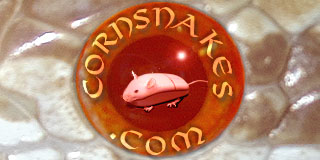From my retired SerpenCo.com website.
Blood Red Corn Snake
As might be easily surmised from the name, this particular cultivar of corn snake is readily identified (at least as an adult) by the relatively uniform orange-red to deep red coloration of the entire body. The abdomen is normally unmarked with black, with a greater majority of white coloration predominating. Many individuals will have the abdomen mottled with orange splotches, which appears to become heavier towards the posterior. The typical corn snake pattern can be pretty nearly completely absent in mature adults, but more typically you will see a faint pattern often delineated with narrow black borders. It appears that the large amount of outcrossing of this cultivar has substantially changed the overall look of the Blood Red in that the original dark deep red coloration has been mostly replaced be a more orange-red appearance. Some people will claim that something was lost from the original strain, whereas others may claim that something was gained. Perhaps there is an obscure genetic component affecting the red coloration that at one time may have predominated in this cultivar. A case can certainly be made for this possibility when you look at some varieties of the Miami Phase and Milk Snake Phase corns which can have eye-catching deep red blotches differing from the more normally seen orange-red coloration.
The Blood Red corn is in some ways a mystery, genetically. The original stock was produced as a selective breeding project by Eddie Leach working with animals from an area roughly from Hastings, Palatka, and St. Augustine areas in northeast Florida. The result was a corn snake that nearly lacked all pattern and the abdomen sported mostly or all white coloration, lacking any black pigment usually seen in a normally colored corn snake. Most likely all of the stock currently being worked with came through the hands of Bill and Kathy Love when they marketed this cultivar beginning in the early '80s.
The 'genetic mystery' mentioned above is from the fact that the Blood Red 'traits' are not very predictable when outcrossed. Some indications point to one or more phenotypic expressions being controlled by simple Mendellian genetics, whereas others defy prediction. It is not at all unusual to get F1 animals that may mature to be nearly Blood Red in appearance, yet lack the classic abdominal coloration. Then on the other hand, you may also get animals that will appear to be normally colored, yet have a large proportion of the abdominal area nearly all white or just have traces of black pattern at the very edges of the abdomin. The F2 generation will certainly have you scratching your head as you try to figure out exactly what is what in those hatchlings!
Babies of the Blood Red can throw most people for a loop. They look nothing at all like the adults they came from. Most will typically have oddly patterned, or nearly patternless heads, with what looks like broad saddles down the back. In the best of them, there will be no lateral pattern at all visible. The abdomen is usually a dead giveaway in that it will usually be white with no black markings and only a scattering of the orange mottling.
The Blood Reds got a very bad black eye reputation years ago as being very problematic feeders. In many cases, this was a well deserved reputation, whereas in others it was just a misunderstanding. Many of the Blood Red babies were VERY insistent about being provided green anoles as their only food source, stubbornly refusing to accept our ideas about them accepting pinky mice, and often starving to death as the argument between the keeper and the kept raged. Even the Cuban brown anoles were not acceptable fare for them. Once this little quirk was realized, it was not at all unusual to get the majority of Blood Red hatchlings started and thriving. And once the feeding response was firmly established, scenting of pinky mice with the green anoles was usually always successful in producing ravenously feeding mouse eaters out of them.
This cultivar has recently taken a surprising jump in popularity that has caught many breeders by surprise. The last couple of years, I have been using my breeding stock of this line merely to use as genetic material for future projects and have basically let the Blood Red stocks dwindle. Plagued with problems in the past because of weakened bloodlines, the newer generations are showing the hardiness that the corn snake is famous for. Matter of fact, once you get the Blood Reds started on pinkies, they easily become the most aggressive feeders around here. The abdomen tends to be various percentages of a combination of white and orange pigments. Only a very few will be available this year as the few adults I have are used for future projects more than producing stock for sale. Some obvious projects in the works are Lavender Blood Reds, Caramel Blood Reds, and Butter Blood Reds. Of course, new names will undoubtedly have to be created for these new cultivars and naming them will certainly be a challenge. Especially the Caramel Blood Reds. My mind's eye view of this particular animal keeps bringing up the name of Blood Clot Corn, but somehow I don't think it will be a commercially attractive name to apply to a corn snake. And then there is the problem of the Butter Blood Red. Seems like an AWFUL lot of trouble to go through just to produce a corn snake that should look amazingly like a Yellow Rat Snake.
